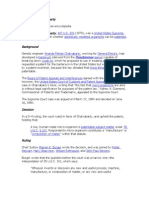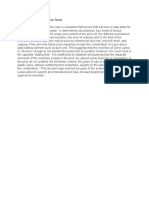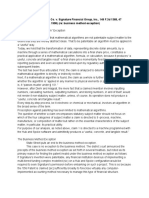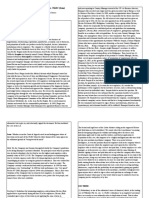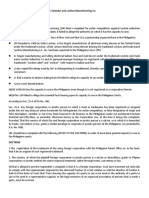Diamond v. Chakrabarty, 447 U.S. 303, 206 U.S.P.Q. (BNA) 193 (1980)
Uploaded by
Eugene LabellaDiamond v. Chakrabarty, 447 U.S. 303, 206 U.S.P.Q. (BNA) 193 (1980)
Uploaded by
Eugene LabellaDiamond v. Chakrabarty, 447 U.S. 303, 206 U.S.P.Q.
(BNA) 193 (1980)
In this case, the court ruled that man-made microorganisms may be patented. A live,
man-made microorganism is a non-naturally occurring composition and therefore may be
patented.
The court relied on a statute which defines as patentable any new useful manufacture or
composition of matter among other things.
In choosing such expansive terms as "manufacture" and "composition of matter,"
modified by the comprehensive "any," Congress contemplated that the patent laws should
be given wide scope, and the relevant legislative history also supports a broad
construction. While laws of nature, physical phenomena, and abstract ideas are not
patentable, respondent's claim is not to a hitherto unknown natural phenomenon, but to a
nonnaturally occurring manufacture or composition of matter - a product of human
ingenuity "having a distinctive name, character [and] use."
The court further held that there can be little doubt that microorganisms produced by
recombinant DNA technology may be said to be manufactured and to be compositions of
matter. For purposes of patent law, the fact they are alive is not relevant. Although it is
true that naturally-occurring products may not be patented, a genetically-engineered
microorganism is not naturally occurring.
While this Court recognizes that recombinant DNA technology is a controversial field, it
is ill-equipped to balance the competing values and interests manifested therein; this is a
task for Congress.
Since the patent laws clearly include materials such as are at issue here within their
scope, and no specific law exists to exclude it, the only appropriate holding is that
recombinant DNA-produced microorganisms are patentable.
You might also like
- Diamond v. Chakraborty 447 U.S. 303 1980 PDFNo ratings yetDiamond v. Chakraborty 447 U.S. 303 1980 PDF8 pages
- Case Analysis Name of The Case: Decided On: Citation No: Judges: 1. Assenting Judges:-2. Dissenting JudgesNo ratings yetCase Analysis Name of The Case: Decided On: Citation No: Judges: 1. Assenting Judges:-2. Dissenting Judges8 pages
- Patent Case Brief - Diamond v. Chakrabarty: Spread The LoveNo ratings yetPatent Case Brief - Diamond v. Chakrabarty: Spread The Love7 pages
- Untitled Document - 2023-11-21T143806.586No ratings yetUntitled Document - 2023-11-21T143806.58611 pages
- Patent Case Brief - Diamond v. Chakraborty - Notes For Free PDFNo ratings yetPatent Case Brief - Diamond v. Chakraborty - Notes For Free PDF3 pages
- Patentable Subject Matter: Chapter EighteenNo ratings yetPatentable Subject Matter: Chapter Eighteen46 pages
- SECTION 21. Patentable Inventions:: May A Live, Man-Made Microorganism Be Patented?No ratings yetSECTION 21. Patentable Inventions:: May A Live, Man-Made Microorganism Be Patented?4 pages
- Biotechnology Patents_Subject Matter ExclusionsNo ratings yetBiotechnology Patents_Subject Matter Exclusions19 pages
- Diamond v. Chakrabarty, 447 U.S. Supreme Court 303 (1980) - 0No ratings yetDiamond v. Chakrabarty, 447 U.S. Supreme Court 303 (1980) - 03 pages
- Diamond v. Chakrabarty, 447 U.S. 303 (1980)No ratings yetDiamond v. Chakrabarty, 447 U.S. 303 (1980)16 pages
- Syllabus: Diamond vs. Chakrabarty, 447 US 303No ratings yetSyllabus: Diamond vs. Chakrabarty, 447 US 30356 pages
- Diamond vs. Chakrabarty: Plasmids Providing A Separate Hydrocarbon Degradative Pathway) ThemselvesNo ratings yetDiamond vs. Chakrabarty: Plasmids Providing A Separate Hydrocarbon Degradative Pathway) Themselves2 pages
- Mayo Collaborative Servs. v. Prometheus Labs., IncNo ratings yetMayo Collaborative Servs. v. Prometheus Labs., Inc13 pages
- Forty Years Since Diamond V ChakrabartyNo ratings yetForty Years Since Diamond V Chakrabarty14 pages
- The Intersection of Biotechnology and Health Issues in IP Law: RIPL's Special Issue 2011From EverandThe Intersection of Biotechnology and Health Issues in IP Law: RIPL's Special Issue 2011No ratings yet
- Diamond v. Chakrabarty: A Retrospective On 25 Years of Biotech PatentsNo ratings yetDiamond v. Chakrabarty: A Retrospective On 25 Years of Biotech Patents4 pages
- Diamond v. Chakrabarty: Brief Fact SummaryNo ratings yetDiamond v. Chakrabarty: Brief Fact Summary17 pages
- Com of Patents V Canadian Council of Churches Et Al 4 SCR.45 2002 SCCNo ratings yetCom of Patents V Canadian Council of Churches Et Al 4 SCR.45 2002 SCC3 pages
- KR Mangalam University: Department of LawNo ratings yetKR Mangalam University: Department of Law13 pages
- IPL - Patent - Compiled Cases Lecture 1No ratings yetIPL - Patent - Compiled Cases Lecture 120 pages
- Conceptual Issues in Patenting of Life FormsNo ratings yetConceptual Issues in Patenting of Life Forms7 pages
- Patenting of Transgenic Genes, DNA Sequences Andisolated GenesNo ratings yetPatenting of Transgenic Genes, DNA Sequences Andisolated Genes5 pages
- Patent of Biotechnlogy Issues and Challenges:-With Special Refrence To Morality and Ethical AspectNo ratings yetPatent of Biotechnlogy Issues and Challenges:-With Special Refrence To Morality and Ethical Aspect15 pages
- Conceptual Issues in Patenting of Life Forms.No ratings yetConceptual Issues in Patenting of Life Forms.7 pages
- Patents and How to Get One: A Practical HandbookFrom EverandPatents and How to Get One: A Practical HandbookNo ratings yet
- State Street Bank & Trust Co. v. Signature Financial Group, Inc., 149 F.3d 1368, 47 U.S.P.Q.2d 1596 (Fed. Cir. 1998) (Re: Business Method Exception)No ratings yetState Street Bank & Trust Co. v. Signature Financial Group, Inc., 149 F.3d 1368, 47 U.S.P.Q.2d 1596 (Fed. Cir. 1998) (Re: Business Method Exception)2 pages
- G.R. No. 138322 October 2, 2001 GRACE J. GARCIA, A.K.A. GRACE J. GARCIA-RECIO, Petitioner, REDERICK A. RECIO, Respondents. Panganiban, J.No ratings yetG.R. No. 138322 October 2, 2001 GRACE J. GARCIA, A.K.A. GRACE J. GARCIA-RECIO, Petitioner, REDERICK A. RECIO, Respondents. Panganiban, J.9 pages
- Issue: Whether The Factual Findings of LA and NLRC Should Be Disturbed?No ratings yetIssue: Whether The Factual Findings of LA and NLRC Should Be Disturbed?4 pages
- 006 Becton Dickinson Philippines Inc. v. NLRC (Lim)No ratings yet006 Becton Dickinson Philippines Inc. v. NLRC (Lim)6 pages
- Victoranio Sablan Marcelina Edroso (Reservista) (Origin) : Pablo and Basilio Sablan (Reservatrios)No ratings yetVictoranio Sablan Marcelina Edroso (Reservista) (Origin) : Pablo and Basilio Sablan (Reservatrios)1 page









